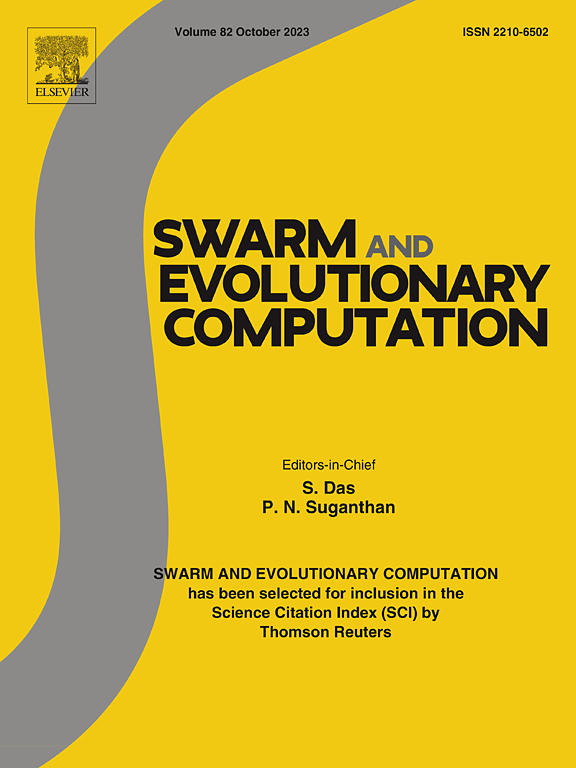基于双空间注意机制的大规模多目标优化框架
IF 8.5
1区 计算机科学
Q1 COMPUTER SCIENCE, ARTIFICIAL INTELLIGENCE
引用次数: 0
摘要
现有的基于注意力的大规模多目标优化(LMOAM)方法只关注决策变量,利用它们的方差来指导搜索行为。然而,在求解多模态多目标优化问题时,单空间策略忽略了目标空间中的关键信息,导致算法的多样性和搜索效率降低。为了解决这一问题,本文提出了一种集成双空间注意机制的大规模优化框架。与仅利用决策空间中的信息构建注意力不同,该框架首先设计了一个结合决策变量和目标空间分布来量化变量重要性的双空间Key矩阵,以提高注意力的精度。随后,采用跨空间聚类方法,通过分析两个空间中个体的特征,选择具有代表性的解,构建查询矩阵。提高了注意力分配的准确性。最后,采用线性逆映射策略,通过将有希望的目标空间解转换回决策空间来增强种群的多样性。与现有方法不同的是,该方法将决策和客观空间的特征与一种新的关注机制联系起来,使人口的开发和利用得到很好的平衡。在两个具有500维和1000维决策变量的基准测试集以及电压互感器优化问题上设计了三种类型的实验来验证AIDF框架的有效性,实验结果表明AIDF在IGD和HV的平均性能方面优于比较算法。本文章由计算机程序翻译,如有差异,请以英文原文为准。
A large-scale multi-objective optimization framework based on a dual-space attention mechanism
Existing attention-based methods for large-scale multi-objective optimization (LMOAM) focus only on decision variables, using their variance to guide search behavior. However, single-space strategies ignore critical information in the objective space and the diversity and search efficiency are often degraded for solving multimodal multi-objective optimization problems (MOPs). To address this problem, a novel large-scale optimization framework that integrates a dual-space attention mechanism is proposed in this paper. Different from building attention only with information in decision space, a dual-space Key matrix that quantifies variable importance by combining decision-variable and objective-space distributions is first designed in the framework to refine the precision of the attention. Subsequently, a cross-space clustering method is adopted to select the representative solutions by analyzing the characteristics of individuals in both spaces to construct the Query matrix. The accuracy of attention allocation is improved. Finally, A linear inverse mapping strategy is used to enhance the diversity of the population by translating promising objective-space solutions back to the decision space. Unlike existing approaches, the characteristics of decision and objective space are linked with a new attention mechanism, and the exploration and exploitation of the population are well balanced. Three types of experiments are designed on two benchmark test sets with 500-dimensional and 1000-dimensional decision variables and the voltage transformer optimization problem to demonstrate the efficacy of the AIDF framework, experimental results indicate that AIDF surpasses comparative algorithms in terms of the average performance of IGD and HV.
求助全文
通过发布文献求助,成功后即可免费获取论文全文。
去求助
来源期刊

Swarm and Evolutionary Computation
COMPUTER SCIENCE, ARTIFICIAL INTELLIGENCEC-COMPUTER SCIENCE, THEORY & METHODS
CiteScore
16.00
自引率
12.00%
发文量
169
期刊介绍:
Swarm and Evolutionary Computation is a pioneering peer-reviewed journal focused on the latest research and advancements in nature-inspired intelligent computation using swarm and evolutionary algorithms. It covers theoretical, experimental, and practical aspects of these paradigms and their hybrids, promoting interdisciplinary research. The journal prioritizes the publication of high-quality, original articles that push the boundaries of evolutionary computation and swarm intelligence. Additionally, it welcomes survey papers on current topics and novel applications. Topics of interest include but are not limited to: Genetic Algorithms, and Genetic Programming, Evolution Strategies, and Evolutionary Programming, Differential Evolution, Artificial Immune Systems, Particle Swarms, Ant Colony, Bacterial Foraging, Artificial Bees, Fireflies Algorithm, Harmony Search, Artificial Life, Digital Organisms, Estimation of Distribution Algorithms, Stochastic Diffusion Search, Quantum Computing, Nano Computing, Membrane Computing, Human-centric Computing, Hybridization of Algorithms, Memetic Computing, Autonomic Computing, Self-organizing systems, Combinatorial, Discrete, Binary, Constrained, Multi-objective, Multi-modal, Dynamic, and Large-scale Optimization.
 求助内容:
求助内容: 应助结果提醒方式:
应助结果提醒方式:


